Tutorial 9: Learning the Inverse Design Map#
In this tutorial, we explore how to infer device geometry from Hamiltonian parameters by learning the inverse design map. We introduce a custom machine learning architecture tailored to capture the underlying physics of this mapping. Specifically, we aim to answer:
Which design space parameters most significantly influence a given set of Hamiltonian parameters?
How does each Hamiltonian parameter quantitatively depend on these key design variables?
Note: This tutorial was originally created for theQuantum Device Workshop, and includes some optional “tasks” for workshop participants. Feel free to skip these if you’re just interested in the main content.
Environment Setup Recommendation#
We strongly recommend creating a separate Python environment for this notebook to ensure all dependencies are installed and to avoid conflicts with your base environment.
[ ]:
%load_ext autoreload
%autoreload 2
%matplotlib inline
Our Model:#
We propose a two-model architecture to understand the physics of the Hamiltonian-Design space mapping.
Design-Relevance Encoder The first stage is a lightweight model (e.g., Random Forest or Lasso) that identifies the subset of geometric design parameters most relevant to each Hamiltonian parameter. This compresses the full design space into a minimal, interpretable feature subset for each target Hamiltonian.
KAN-based Symbolic Decoder The second model, a Kolmogorov–Arnold Network (KAN) is trained to symbolically model the Hamiltonian parameter as a function of only its relevant design variables. The KAN outputs a closed-form symbolic expression, enabling direct interpretation of the underlying physics-driven dependency.
Design-Relevance Encoder#
The Design-Relevance Encoder identifies which geometric parameters \(\boldsymbol{\xi}\) most influence each target Hamiltonian parameter \(\hat{\mathcal{H}}\). To do this, we train an interpretable model — Lasso regression — to predict each Hamiltonian component from the full set of geometric inputs.
Lasso (Least Absolute Shrinkage and Selection Operator) selects relevant features via coefficient shrinkage, automatically zeroing out irrelevant ones.
By using this model’s outputs we construct a relevance mask that tells us which subset of design parameters significantly affect each \(\hat{\mathcal{H}}\). This subset is then used as input to symbolic regression (e.g. KAN) to extract compact, human-readable expressions.
[2]:
import pandas as pd
import numpy as np
from sklearn.model_selection import train_test_split
from sklearn.preprocessing import StandardScaler
import json
from sklearn.ensemble import RandomForestRegressor
from sklearn.linear_model import MultiTaskLassoCV
from sklearn.preprocessing import StandardScaler
from sklearn.tree import plot_tree
import torch
import sympy as sp
import matplotlib.pyplot as plt
import random
Let’s use the training dataset we generated in Tutorial 7
[3]:
training_df = pd.read_parquet("data/training_data.parquet")
[4]:
hamiltonian_parameters = ['qubit_frequency_GHz', 'anharmonicity_MHz', 'cavity_frequency_GHz', 'kappa_kHz', 'g_MHz']
design_parameters = ['cross_length', 'claw_length','coupling_length', 'total_length','ground_spacing']
[5]:
Y_hamiltonian = training_df[hamiltonian_parameters].values # Hamiltonian parameters
X_design = training_df[design_parameters].values # Design parameters
The following object implemets the LASSO model to serve as the Design-Relevance Encoder
[6]:
class DesignRelevanceEncoder:
def __init__(self, X_design, Y_hamiltonian, design_labels, hamiltonian_labels):
"""
Initialize the analyzer with design inputs and Hamiltonian outputs.
"""
self.X_raw = X_design
self.Y_raw = Y_hamiltonian
self.design_labels = design_labels
self.hamiltonian_labels = hamiltonian_labels
self.scaler_X = StandardScaler()
self.scaler_Y = StandardScaler()
self.X = self.scaler_X.fit_transform(self.X_raw)
self.Y = self.scaler_Y.fit_transform(self.Y_raw)
def run_random_forest(self, n_estimators=200, random_state=42):
"""
Trains a random forest for each Hamiltonian parameter.
Stores and returns a feature importance DataFrame.
"""
importance_matrix = np.zeros((self.X.shape[1], self.Y.shape[1]))
for i, h_name in enumerate(self.hamiltonian_labels):
rf = RandomForestRegressor(n_estimators=n_estimators, random_state=random_state)
rf.fit(self.X, self.Y[:, i])
importance_matrix[:, i] = rf.feature_importances_
self.rf_importance_df = pd.DataFrame(importance_matrix,
index=self.design_labels,
columns=self.hamiltonian_labels)
return self.rf_importance_df
def run_multitask_lasso(self, alpha_grid=np.logspace(-4, 1, 20)):
"""
Trains a multi-task Lasso model.
Stores and returns the coefficient matrix as DataFrame.
"""
model = MultiTaskLassoCV(alphas=alpha_grid, cv=5, random_state=42)
model.fit(self.X, self.Y)
coef_matrix = model.coef_.T # (n_design, n_hamiltonian)
self.lasso_coef_df = pd.DataFrame(coef_matrix,
index=self.design_labels,
columns=self.hamiltonian_labels)
return self.lasso_coef_df
def plot_heatmaps(self):
"""
Plots side-by-side heatmaps of RF and Lasso results.
"""
fig, axs = plt.subplots(1, 2, figsize=(16, 6))
sns.heatmap(self.rf_importance_df,
annot=True, cmap="YlOrRd", ax=axs[0], cbar_kws={'label': 'Feature Importance'})
axs[0].set_title("Random Forest: Design Parameter Importance")
axs[0].set_xlabel("Hamiltonian Parameter")
axs[0].set_ylabel("Design Parameter")
sns.heatmap(self.lasso_coef_df,
annot=True, center=0, cmap="coolwarm", ax=axs[1], cbar_kws={'label': 'Coefficient Value'})
axs[1].set_title("Multi-Task Lasso: Design Influence")
axs[1].set_xlabel("Hamiltonian Parameter")
axs[1].set_ylabel("Design Parameter")
plt.tight_layout()
plt.show()
def print_dependency_summary(self, top_k=3, threshold=1e-3):
"""
Prints top-k most important design variables per Hamiltonian parameter
from both Random Forest and Lasso results.
"""
print("\n=== Top Influencers from Random Forest ===")
for h in self.hamiltonian_labels:
top = self.rf_importance_df[h].sort_values(ascending=False)
print(f"\n- {h}:")
for i in range(top_k):
print(f" • {top.index[i]} → importance = {top.values[i]:.4f}")
print("\n=== Top Influencers from Lasso (with direction) ===")
for h in self.hamiltonian_labels:
top = self.lasso_coef_df[h].abs().sort_values(ascending=False)
print(f"\n- {h}:")
for i in range(top_k):
param = top.index[i]
coef = self.lasso_coef_df[h][param]
print(f" • {param} → coef = {coef:.4f} ({'↑' if coef > 0 else '↓'})")
def plot_heatmap(self):
"""
Plots a single heatmap depending on which model was run.
If both are run, plots both side by side.
If only one is run, plots only that one.
"""
has_rf = hasattr(self, 'rf_importance_df')
has_lasso = hasattr(self, 'lasso_coef_df')
if has_rf and has_lasso:
self.plot_heatmaps()
elif has_rf:
plt.figure(figsize=(8, 6))
sns.heatmap(self.rf_importance_df, annot=True, cmap="YlOrRd", cbar_kws={'label': 'Feature Importance'})
plt.title("Random Forest: Design Parameter Importance")
plt.xlabel("Hamiltonian Parameter")
plt.ylabel("Design Parameter")
plt.tight_layout()
plt.show()
elif has_lasso:
plt.figure(figsize=(8, 6))
sns.heatmap(self.lasso_coef_df, annot=True, center=0, cmap="coolwarm", cbar_kws={'label': 'Coefficient Value'})
plt.title("Multi-Task Lasso: Design Influence")
plt.xlabel("Hamiltonian Parameter")
plt.ylabel("Design Parameter")
plt.tight_layout()
plt.show()
else:
raise ValueError("Neither Random Forest nor Lasso results are available. Run one of the analysis methods first.")
def get_dependency_summary_json(self, top_k=3, threshold=1e-3, pretty_print=True):
"""
Returns a JSON-like dict of top design parameters (and their scores) for each Hamiltonian parameter.
Only includes parameters with absolute score above the threshold.
If both models are run, returns both. Otherwise, returns only the available one.
If pretty_print is True, also prints the summary in a human-readable format.
"""
summary = {}
if hasattr(self, 'rf_importance_df'):
rf_summary = {}
for h in self.hamiltonian_labels:
top = self.rf_importance_df[h].sort_values(ascending=False)
filtered = [
{"parameter": top.index[i], "importance": float(top.values[i])}
for i in range(len(top))
if abs(top.values[i]) >= threshold
][:top_k]
rf_summary[h] = filtered
summary['random_forest'] = rf_summary
if hasattr(self, 'lasso_coef_df'):
lasso_summary = {}
for h in self.hamiltonian_labels:
top = self.lasso_coef_df[h].abs().sort_values(ascending=False)
filtered = [
{
"parameter": top.index[i],
"coef": float(self.lasso_coef_df[h][top.index[i]])
}
for i in range(len(top))
if abs(top.values[i]) >= threshold
][:top_k]
lasso_summary[h] = filtered
summary['lasso'] = lasso_summary
if pretty_print:
print("\n=== Dependency Summary (Top {} per Hamiltonian parameter, threshold={}) ===".format(top_k, threshold))
print(json.dumps(summary, indent=4))
return summary
[7]:
ml_analyzer = DesignRelevanceEncoder(
X_design,
Y_hamiltonian,
design_labels=design_parameters,
hamiltonian_labels=hamiltonian_parameters
)
[8]:
ml_analyzer.run_multitask_lasso()
[8]:
| qubit_frequency_GHz | anharmonicity_MHz | cavity_frequency_GHz | kappa_kHz | g_MHz | |
|---|---|---|---|---|---|
| cross_length | -0.956645 | 0.904895 | 0.000207 | 0.000060 | -0.574872 |
| claw_length | -0.005958 | 0.007807 | -0.220192 | -0.141799 | 0.932547 |
| coupling_length | -0.000277 | 0.000236 | -0.153045 | 0.877849 | -0.073914 |
| total_length | 0.000482 | -0.000646 | -0.924025 | -0.484510 | -0.394851 |
| ground_spacing | -0.001715 | 0.002270 | 0.000009 | 0.000282 | -0.350630 |
[9]:
ml_analyzer.plot_heatmap()
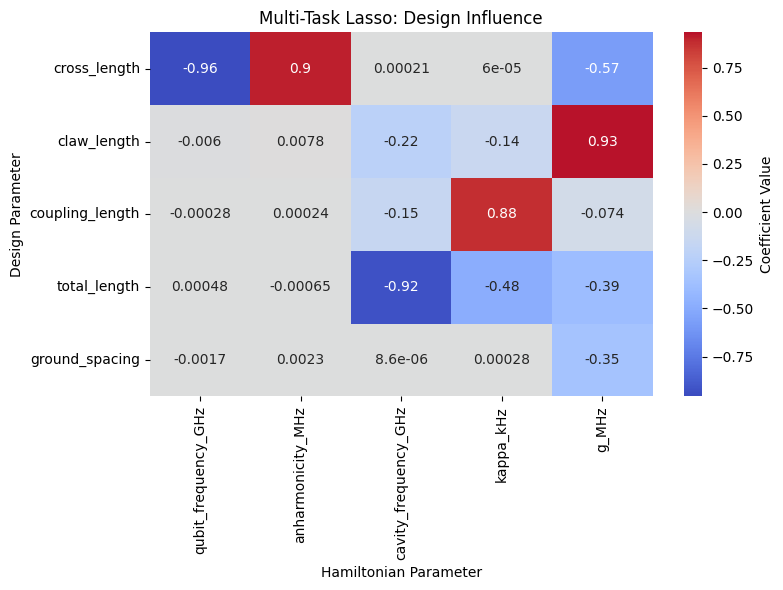
[10]:
dependency_summary = ml_analyzer.get_dependency_summary_json(top_k=2, threshold=0.1)
=== Dependency Summary (Top 2 per Hamiltonian parameter, threshold=0.1) ===
{
"lasso": {
"qubit_frequency_GHz": [
{
"parameter": "cross_length",
"coef": -0.9566450702946909
}
],
"anharmonicity_MHz": [
{
"parameter": "cross_length",
"coef": 0.9048951896956229
}
],
"cavity_frequency_GHz": [
{
"parameter": "total_length",
"coef": -0.9240245095002161
},
{
"parameter": "claw_length",
"coef": -0.22019159774679983
}
],
"kappa_kHz": [
{
"parameter": "coupling_length",
"coef": 0.8778486103719524
},
{
"parameter": "total_length",
"coef": -0.48451014050957547
}
],
"g_MHz": [
{
"parameter": "claw_length",
"coef": 0.932547254832365
},
{
"parameter": "cross_length",
"coef": -0.5748717548177499
}
]
}
}
KAN Decoder#
The KAN (Kolmogorov–Arnold Network) decoder learns a compact symbolic expression for a Hamiltonian parameter based on a subset of relevant geometric features. Unlike traditional neural networks, KAN explicitly fits interpretable functional forms using trainable basis functions, revealing the underlying physics in closed-form expressions. After training, the network can be pruned and symbolic expressions extracted using a user-defined library of functions, yielding formulas that capture how design geometry affect the Hamiltonian parameters
Example: Selecting Features and Target for KAN#
In this example flow, we demonstrate how to set up the KAN model for inverse design. First, we select the Hamiltonian parameter to model—in this case, the cavity frequency \(f_{cav}\) (in GHz). Next, using the results from the Design-Relevance Encoder, we identify ``total_length`` and ``claw_length`` as the two most influential design parameters for predicting cavity_frequency.
We then proceed to extract and process the relevant features from the training dataset to prepare for model training.
[11]:
target_feature = 'cavity_frequency_GHz'
[12]:
input_features = [i["parameter"] for i in dependency_summary["lasso"][target_feature]]
input_features
[12]:
['total_length', 'claw_length']
[13]:
X = training_df[input_features].values
y = training_df[target_feature].values.reshape(-1, 1)
# Split into train/val
X_train, X_val, y_train, y_val = train_test_split(X, y, test_size=0.25, random_state=42)
# Convert to PyTorch tensors
train_input = torch.tensor(X_train, dtype=torch.float32)
test_input = torch.tensor(X_val, dtype=torch.float32)
train_label = torch.tensor(y_train, dtype=torch.float32)
test_label = torch.tensor(y_val, dtype=torch.float32)
# Final dataset dict for pykan
dataset = {
"train_input": train_input,
"test_input": test_input,
"train_label": train_label,
"test_label": test_label
}
KAN Model Setup#
We now define and initialize the Kolmogorov–Arnold Network (KAN) model to learn a symbolic expression for the Hamiltonian parameter \(f_{cav}\). The chosen architecture KAN(width=[2, 2, 1], grid=5, k=3) reflects:
Input layer with 2 neurons for the two most relevant geometric features:
total_lengthandclaw_length.One hidden layer with 2 units, each equipped with a set of grid-based basis functions.
Output layer producing a single scalar value corresponding to
cavity_frequency_GHz.
The grid parameter sets how many grid points each neuron’s nonlinear activation uses: increasing grid allows the model to capture more complex, detailed functions, but may reduce smoothness and interpretability; decreasing it makes the model simpler and smoother, but less expressive. The k parameter controls local smoothing by determining how many nearby grid points influence each output: higher k values produce smoother, more robust functions, while lower k values allow for
sharper, more localized changes in the learned function.
Setting random seed to 0 to ensure reproducibility 🤞🏽
[15]:
torch.manual_seed(0)
np.random.seed(0)
random.seed(0)
[16]:
from kan import *
[17]:
model = KAN(width=[2,2,1], grid=5, k=3)
model(dataset['train_input']);
model.plot(beta=100)
checkpoint directory created: ./model
saving model version 0.0

This plot shows the untrained KAN model for predicting cavity frequency from total_length and claw_length. Each black dot represents an input, which is passed through learnable univariate function blocks (squares) that apply symbolic transformations (e.g., x, x², sin). These transformed features are summed (white “+” nodes) to build the output. At this stage, all functions are uninitialized (linear ramps), and the structure reflects the model’s capacity to discover symbolic
patterns through training.
Encouraging Symbolic Simplicity#
Before training, we configure two key regularization terms that guide the KAN model toward interpretable symbolic solutions:
``lamb`` (L2 sparsity penalty): This term encourages the weights of the model to be small, reducing model complexity. A higher value forces the network to use fewer basis functions and promotes sparsity in the learned representation.
``lamb_entropy`` (functional entropy penalty): This term penalizes overly complex or chaotic nonlinear transformations by minimizing the entropy of the learned functional basis. It nudges the network to favor smooth, low-entropy functions like polynomials, sinusoids, or exponentials.
Together, these regularizers bias the training process toward compact, human-readable formulas instead of overfitted black-box predictions.
[18]:
metrics = model.fit(dataset, steps=100, lamb=0.01, lamb_entropy=10)
| train_loss: 3.28e-01 | test_loss: 3.30e-01 | reg: 5.57e+00 | : 100%|█| 100/100 [02:39<00:00, 1.60
saving model version 0.1
[19]:
fig, axs = plt.subplots(len(metrics), 1, figsize=(6, 3 * len(metrics)), sharex=True)
if len(metrics) == 1:
axs = [axs]
for i, key in enumerate(metrics.keys()):
axs[i].plot(metrics[key])
axs[i].set_yscale('log')
axs[i].set_title(key)
axs[i].set_ylabel(key)
axs[-1].set_xlabel('Step')
plt.tight_layout()
plt.show()
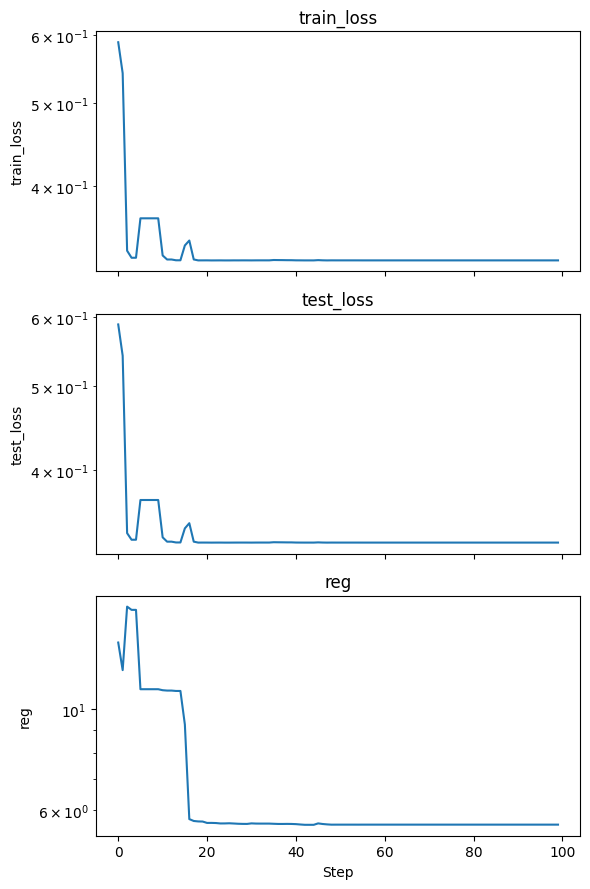
Lets visualize the trained KAN model.
[20]:
model.plot()
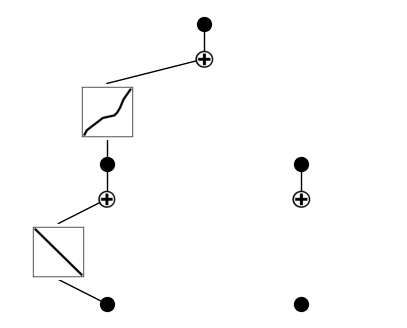
After training, the model has learned to rely primarily on the total meander length input, passing it through two distinct nonlinear transformations before summing their outputs to predict the target. The claw length input remains disconnected, indicating it was not found to be predictive by the network during optimization.
As a best practice, we prune the model at this stage to remove redundant or low-contribution paths. This step simplifies the learned symbolic equation, making it more interpretable by eliminating unnecessary neurons and connections that do not significantly impact the prediction. Pruning refines the model architecture before further fine-tuning.
[21]:
model = model.prune()
model(dataset['train_input'])
model.plot()
saving model version 0.2
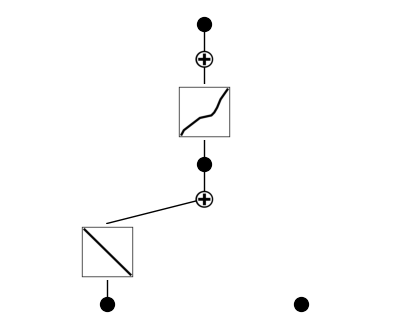
The updated architecture clearly shows that the model now relies on distinct nonlinear transformations of both inputs (total meander length and claw length), though one transformation from claw length is weak and de-emphasized.
We retrain after pruning to slightly adjust the remaining functions for better accuracy.
[22]:
model.fit(dataset, steps=50)
try:
model.plot()
except Exception as e:
print("Error plotting model")
| train_loss: 3.27e-01 | test_loss: 3.30e-01 | reg: 1.66e+00 | : 100%|█| 50/50 [00:39<00:00, 1.27it
saving model version 0.3

Finally, we define a library of candidate symbolic functions (polynomials, sinusoids, logs, etc.). KAN fits the learned internal structure to combinations of these and then extracts the final symbolic formula representing:
[23]:
lib = ['x','x^2','x^3','x^4','exp','log','sqrt','tanh','sin','abs']
model.auto_symbolic(lib=lib)
fixing (0,0,0) with x, r2=1.0000005960464478, c=1
fixing (0,1,0) with 0
fixing (1,0,0) with x, r2=0.9552730917930603, c=1
saving model version 0.4
[95]:
model.symbolic_formula()
[95]:
([-0.00169442449984271*x_1 - 5.35003944827876e-12*x_2 - 5.43009030583892e-6*sin(9.40023994445801*x_2 - 9.61199951171875) + 13.2851943596568],
[x_1, x_2])
Lets visually interpret the symbolic model and compare it to the data.
[24]:
def plot_symbolic_surface(f_sym, x1_range, x2_range, x1_label, x2_label, z_label, title, cmap='plasma'):
"""
Plots a 2D surface of a symbolic model f_sym(x1, x2) over the specified ranges.
"""
X2, X1 = np.meshgrid(x2_range, x1_range)
Z = f_sym(X1, X2)
plt.figure(figsize=(6, 6))
c = plt.pcolormesh(x2_range, x1_range, Z, shading='auto', cmap=cmap)
plt.xlabel(x2_label, fontsize=12)
plt.ylabel(x1_label, fontsize=12)
cbar = plt.colorbar(c, label=z_label)
cbar.ax.tick_params(labelsize=10)
plt.xticks(fontsize=10)
plt.yticks(fontsize=10)
plt.title(title, fontsize=13)
plt.tight_layout()
plt.show()
def plot_symbolic_vs_data(f_sym, x1_vals, fixed_x2, real_X, real_y, x1_col, x2_col, tol, x1_label, x2_label, y_label, title):
"""
Plots the symbolic model prediction vs. real data for a fixed x2 value.
"""
f_pred = f_sym(x1_vals, fixed_x2)
mask = np.abs(real_X[:, x2_col] - fixed_x2) < tol
x1_real = real_X[mask, x1_col]
y_real = real_y[mask]
plt.figure(figsize=(8, 6))
plt.plot(x1_vals, f_pred, label=f'Symbolic Model (fixed {x2_label}={fixed_x2})', color='C0')
plt.scatter(x1_real, y_real, color='C1', edgecolor='k', s=40,
label=f'Real Data (fixed {x2_label}={fixed_x2}±{tol})')
plt.xlabel(x1_label)
plt.ylabel(y_label)
plt.title(title)
plt.legend()
plt.tight_layout()
plt.grid(True)
plt.show()
[25]:
# Define symbolic model
x1, x2 = sp.symbols('x_1 x_2')
expr = (-0.00169442449984271*x1 - 5.35003944827876e-12*x2 - 5.43009030583892e-6*sin(9.40023994445801*x2 - 9.61199951171875) + 13.2851943596568)
f_sym = sp.lambdify((x1, x2), expr, modules='numpy')
# 1. Surface plot
claw_vals = np.linspace(50, 400, 100) # x2: claw length [µm]
meander_vals = np.linspace(2000, 5000, 100) # x1: total meander length [µm]
plot_symbolic_surface(
f_sym,
x1_range=meander_vals,
x2_range=claw_vals,
x1_label='Total Meander Length (µm)',
x2_label='Claw Length (µm)',
z_label='Cavity Frequency (GHz)',
title=r'Symbolic Model: $f_{\mathrm{cav}}(x_1, x_2)$'
)
# 2. Symbolic vs. data plot
fixed_claw = 300
x1_vals = np.linspace(2500, 5000, 200)
input_features = ['total_length', 'claw_length']
target_feature = 'cavity_frequency_GHz'
X = training_df[input_features].values
y = training_df[target_feature].values.reshape(-1)
tol = 5.0 # microns
# x1_col=0 (total_length), x2_col=1 (claw_length)
plot_symbolic_vs_data(
f_sym,
x1_vals=x1_vals,
fixed_x2=fixed_claw,
real_X=X,
real_y=y,
x1_col=0,
x2_col=1,
tol=tol,
x1_label='Total Meander Length (µm)',
x2_label='Claw Length (µm)',
y_label='Cavity Frequency (GHz)',
title=f'Cavity Frequency vs. Meander Length (Claw Length = {fixed_claw} µm)'
)
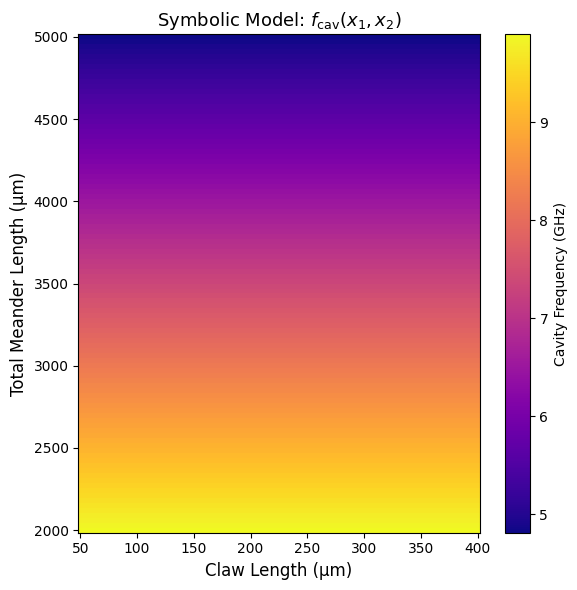
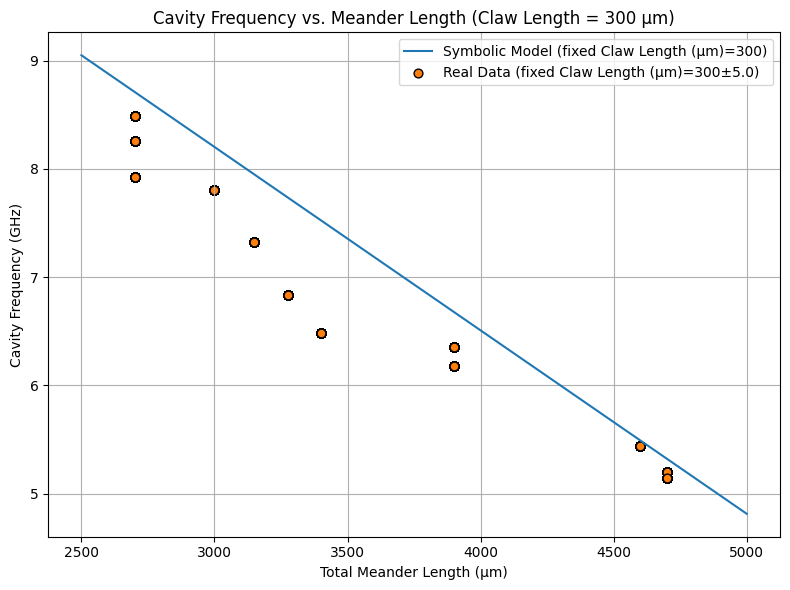
The symbolic expression returned by the KAN model is:
with the following numerical values:
\(a_1 = -1.694 \times 10^{-3}\)
\(a_2 = -5.35 \times 10^{-12}\)
\(a_3 = -5.43 \times 10^{-6}\)
\(b_1 = 9.40\), \(b_2 = -9.61\)
\(a_4 = 13.285\)
Dimensional Analysis and Simplification#
In our dataset:
\(x_1 \in [2000, 5000] \, \mu\text{m}\)
\(x_2 \in [100, 400] \, \mu\text{m}\)
We can estimate the magnitude of each term:
\(a_1 x_1 \sim - 3.5\) — dominant term
\(a_2 x_2 \sim 10^{-9}\) — negligible
\(a_3 \sin(\cdot) \sim 10^{-6}\) — negligible
\(a_4 \sim 13.3\) — dominant constant offset
Thus, to leading order, the model simplifies to:
Interpretation#
In summary, the model shows that total meander length \(x_1\) is the dominant factor affecting cavity frequency, with other terms (including those involving claw length \(x_2\)) being negligible. This matches physical expectations and demonstrates that the symbolic formula found by KAN is both accurate and interpretable, serving as a reliable and efficient surrogate for more complex simulations.
Note: KAN model outcomes are probabilistic—if you do not set a deterministic random seed, you may not obtain the exact same symbolic model or results each time you run this notebook. Additionally, the hyperparameters used here are not fully optimized; further tuning will certainly yield improved performance and interpretability at the cost of training time.
Task 1: Symbolic Discovery with KANs Using Design-Relevance Insights#
Your goal is to explore symbolic relationships between Hamiltonian parameters and the most relevant design variables using a KAN model
Start by choosing a Hamiltonian parameter of interest (e.g., \(g\), \(\alpha_q\)) and use the design-relevance encoder outputs to identify which geometry parameters matter most for that target.
Then:
Use those selected design variables as inputs to the KAN model.
Train KAN to learn an interpretable symbolic mapping from geometry to the Hamiltonian parameter.
Try different architectures, libraries of functions, and pruning thresholds to extract concise and meaningful symbolic expressions. The goal is to gain physical insight into how specific design features influence device behavior — not just predict, but understand.
If your symbolic model makes sense and teaches us something cool, shoot us an email.
[41]:
# ------------------------------
# Helpful to fix the random seed
# ------------------------------
SEED =5212025
np.random.seed(SEED)
random.seed(SEED)
torch.manual_seed(SEED)
torch.backends.cudnn.deterministic = True
torch.backends.cudnn.benchmark = False
[ ]:
# your code here
Task 2:#
I had a similar-ish model (no hyperparameter tuning) for that predicted the following for the coupling strength, \(g\):
Writing it without the constants:
Where:
\(x_1\): cross length (in microns)
\(x_2\): claw length (in microns)
\(a_1, a_2\): linear gain coefficients
\(b\): scale of nonlinear saturation
\(c_1, c_2\): coupling weightings inside the square root
\(d\): baseline offset
It seems to have fitted our data very well.
Reference plot from the SQuADDS paper

Comparision plot to the SQuADDS paper from the model
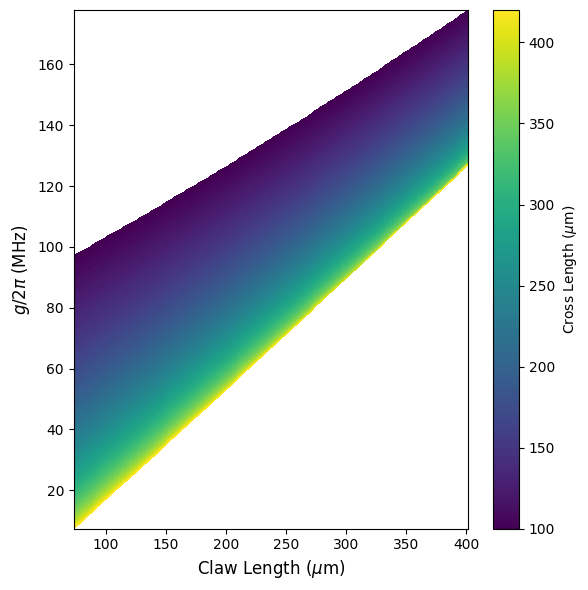
Model prediction

Discuss amongst yourselves to see if this expression is physically meaningful or not.
License#
This code is a part of SQuADDS
Developed by Sadman Ahmed Shanto
This tutorial is written by Sadman Ahmed Shanto
© Copyright Sadman Ahmed Shanto & Eli Levenson-Falk 2025.
This code is licensed under the MIT License. You may obtain a copy of this license in the LICENSE.txt file in the root directory of this source tree.
Any modifications or derivative works of this code must retain thiscopyright notice, and modified files need to carry a notice indicatingthat they have been altered from the originals.

